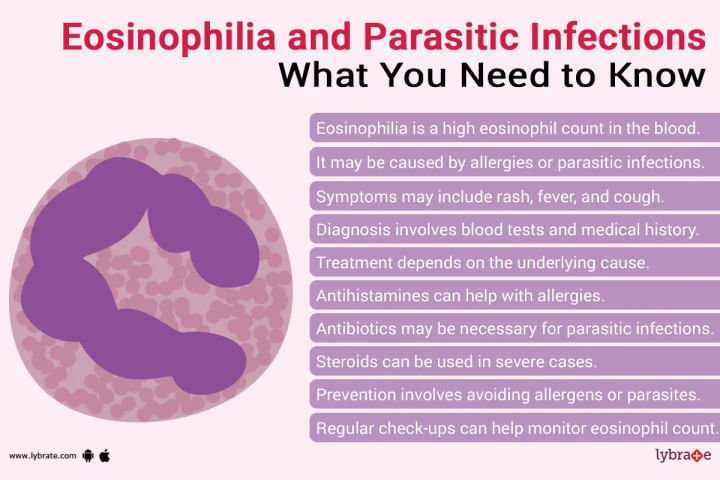Eosinophilia: What is it, its causes, diagnosis, treatment and prevention
Eosinophilia is when the level of eosinophils is higher than normal level in blood. Eosinophils are a type of WBC (white blood cells). These cells are the immune system of our body which helps to fight diseases. When there is parasitic infection, bacterial infection or any type of allergic reaction, these cells help us to fight it. It is also useful in defeating cancer.
If there is an attack of foreign substance/lives there is an increase at levels of eosinophils in blood or if attack is to tissue of a particular area of the body we will find the high levels of eosinophils. Eosinophils get their site to defense via body inflammation property.
When doctors or lab assistants take samples for skin, mucus from nasal area or inside mucus opening or from mouth; they find tissue eosinophilia. When blood is taken for medical procedure if infection is of the whole body we will see the high levels of eosinophils nevertheless there is normal levels of eosinophils.
Blood tests of a human tell about its eosinophils levels, however other types of WBC can be counted. 500/microliter of blood is a measure for normal levels of eosinophils in adults. Range is 500/microlitre to 1,500/ microliter of blood, higher than this can lead to hypereosinophilia/eosinophilia.
Causes:
Eosinophils released by two roles of immune system in order to defende the body:
- Attacking foreign substances/lives: These eosinophils are a type of wbc that defend by consuming the foreign lives. Especially when the immune system warns and targets the foreign parasite they consume them and destroy the parasite inside their body.
- Regulating inflammation: Inflammation given by the body to isolate the infected area from the rest of it. This eosinophils also helps in inflammation to guide the other defense cells used at that site. At sometime due to eosinophils aid in the inflammation the area gets high inflammation and it can get us in trouble. For example asthma or allergies symptoms can be aided to trouble level by eosinophils, in this they cause hay fever. Many times it can cause chronic inflammation in the body.
Some diseases and reaction, invaders in the body can cause to eosinophilia:
- Parasitic and fungal infection.
- Allergic reactions.
- Adrenal conditions.
- Skin disorders
- Toxins
- Autoimmune disorders
- Endocrine disorders
- Tumors
Specific diseases that result in high number of eosinophil causing eosinophilia:
- Acute myelogenous leukemia (AML).
- Allergies
- Ascariasis
- Asthma
- Atopic dermatitis
- Cancer
- Churg-strauss syndrome
- Crohn's diseases
- Drug allergy
- Eosinophilic esophagitis
- Leukemia
- Hay fever
- Hodgkin’s disease
- Hypereosinophilic syndrome
- Lymphatic filariasis
- Ovarian cancer
- Immunodeficiency
- Ulcerative colitis
When to see a doctor :
Eosinophils cause inflammation in various parts of the body. When there is an increase in the levels of eosinophils and disorder occurs called hypereosinophilic syndrome (HES). Eosinophilia do not have symptoms but certain disorder can cause you to visit the doctors:
- Eosinophilic cystitis: Bladder disorder can occur.
- Eosinophilic fasciitis: Facia is a connective tissue that runs through the body. It can cause facial disorders.
- Eosinophilic pneumonia: Affects your lungs.
- Eosinophilic gastrointestinal disorders (EGID): This causes inflammation in the esophagus, colon,intestine area.
- eosinophilic granulomatosis with polyangiitis: Also called by name Churg-Strauss syndrome, which mainly affects heart, lungs and sinuses.
- Hypereosinophilic syndrome: This is a rare syndrome that mainly affects the central nervous system and respiratory tract.
When you find any whereabouts of the above listed you may visit the doctor immediately.
Treatment:
Doctors treat the underlying cause of eosinophilia. Doctors provide steroids or medicine if you have eosinophilic esophagitis. If you have allergies or chronic sinusitis there will be allergy tests to find what causes the high release of eosinophils which thus can be treated.Many medication causes allergic reaction which in turns produces eosinophils. The doctors advised me to stop the medications. In case of cancer chemotherapy is given to stop such allergic reactions.
Prevention:
Many doctors give antigens which cause the reaction for allergy. We can avoid the medicines, dry skin, in winter keep the body warm if there is inflammation. Certain foods can cause inflammation in the stomach, so we should avoid that.
Diagnosis:
Doctors do a CBC (complete blood count) test to know the count of eosinophils. It may do a specific test for counting the eosinophils in the tissue area.
Conclusions:
Eosinophils count can be increased due to many factors at two areas: skin and blood. Such increases are called eosinophilia and when there are high increases in count of eosinophilia called hypereosinophilia. Hypereosinophilia is caused by cancer or drug which is concerning.
Eosinophilia can be caused by certain diseases listed above, treating which we can prevent the inflammatory properties of eosinophils to specific areas. Blood disorders or blood cancer can also cause high counts of eosinophils in blood. By treating the underlying cause we can treat the inflammation. Many have chronic inflammation in the body which is hard to ease down.
There is no such treatment for eosinophils. Whenever you see any syndrome-like signs please visit doctors. Many inflammation is due to medications which should be odd out.



+1.svg)
